
A condo association in Shirlington rolled out tips both smoking and non-smoking homes can implement to prevent the spread of stray smoke.
One suggestion, targeted to marijuana users, is blunt: consider switching to edibles.
Confronted with mounting complaints from residents about smoke from neighbors infiltrating their homes, management for Fairlington Villages reminded smoking residents to be mindful of their neighbors.
The issue is most acute within multifamily buildings in the community, which consists of townhomes and apartments in 2-4 story buildings around S. Abingdon Street in the Shirlington neighborhood. General Manager Gregory Roby told ARLnow his office gets complaints from tenants roughly once a month about tobacco and marijuana smoke drifting from one unit to another.
“This problem was on the decrease, corresponding to the decreasing number of people smoking tobacco products, but has started to turn around with the legalization and ready availability of marijuana,” he said.
On its website and on X, the platform formerly known as Twitter, management suggested different tips for smokers and non-smokers to smoke-proof their homes.
2. Place a wet towel at the bottom of your door to prevent the smoke and odor from entering the hallway.
3. For marijuana consumers, consult your prescribing physician to determine whether edibles may be an effective and non-intrusive delivery method in lieu of smoking.
— Fairlington Villages (@NFairlington) August 9, 2023
In the thread, Fairlington Villages thanked residents in advance for any steps they take to mitigate the negative effects of smoking. While cigarette smokers have to find ways to keep the smoke in, or purify what does escape, the message notes marijuana users can talk to a doctor about switching to edibles.
People need a doctor’s note to get medical marijuana from a dispensary. Arlington’s first medical dispensary opened earlier this year — about a year and a half after Virginia legalized marijuana possession. State efforts to build up an industry around the plant have stalled.
Roby attributes the issue of smoke transferring among units to the age of Fairlington Villages, built more than 75 years ago. He said the walls have large gaps behind cabinets and appliances, as well as open spaces between units, through which smoke pass and even seep into common stairwells.
“Sealing these openings, as well as common-wall outlets, etc., can help decrease unit-to-unit transference,” he noted. “Creating negative pressure in the unit, either by opening a window (depending upon outside pressure) or turning on exhaust fans, helps draw fresh air into the stairwells and units, minimizing the possibility of unit-to-hallway transfer.”
Previously, the condo association has dealt with wilder forms of infiltration, once by a mangy fox and another time by hungry racoons.

